Analysis of Healthcare Communication and Documentation in a Case Study
VerifiedAdded on 2022/08/21
|10
|2490
|11
Report
AI Summary
This report analyzes a case study concerning communication and documentation failures in a healthcare setting, specifically focusing on the death of Troy Almond. The paper identifies missed opportunities in communication among healthcare professionals, including inadequate documentation of vital signs, incorrect entries, and a lack of escalation protocols. It emphasizes the importance of electronic documentation, early warning systems (EWS) like the "Between the Flags" system, and escalation systems such as Ryan's Rule. The report discusses strategies to mitigate communication gaps, including the adoption of electronic health records, accurate clinical handovers, and the implementation of robust escalation of care systems. The conclusion underscores the vulnerability of pediatric patients and the necessity for heightened vigilance, comprehensive monitoring, and timely assessment to prevent adverse outcomes. The paper stresses the need for improved communication and documentation practices to enhance patient safety and prevent similar tragedies in the future.
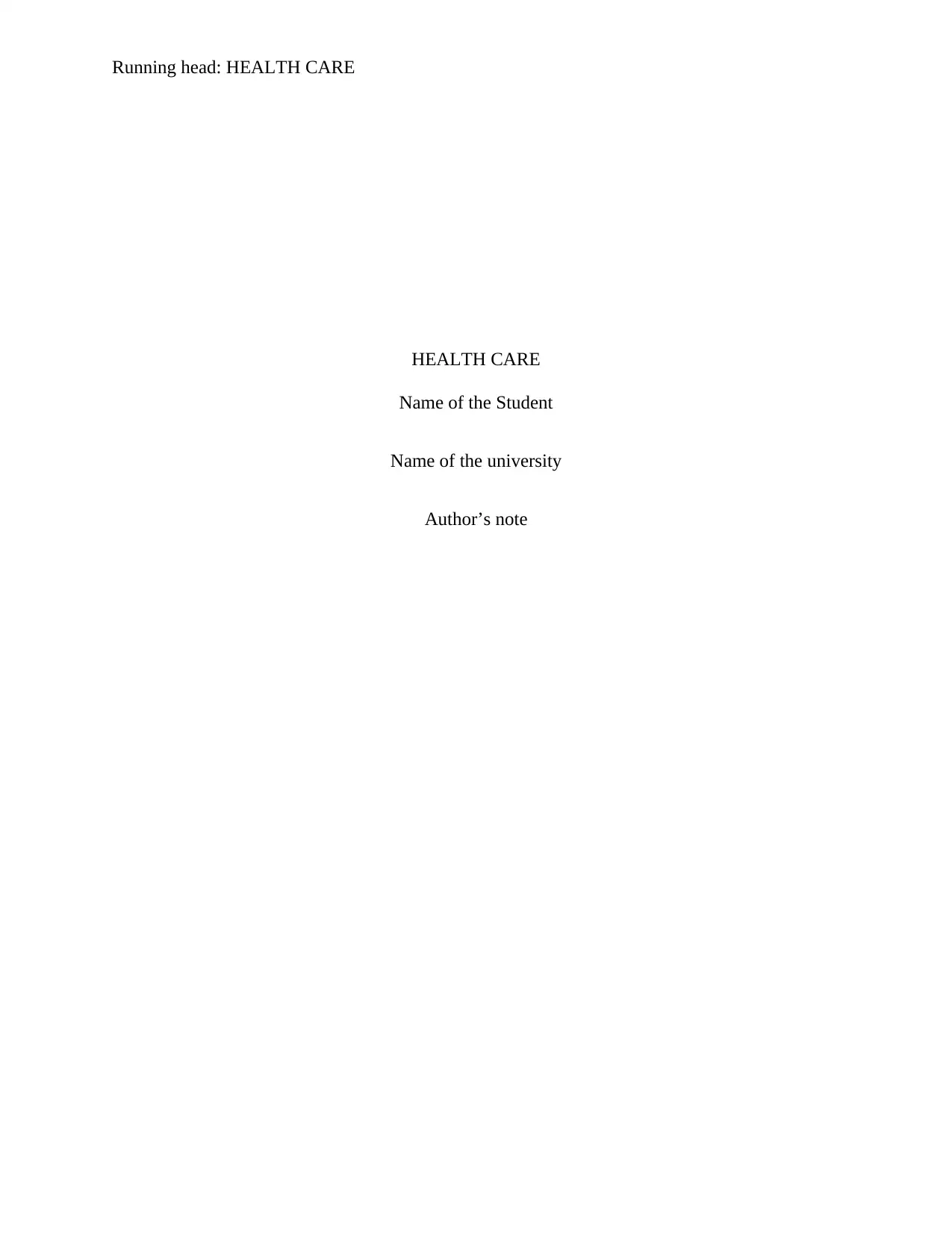
Running head: HEALTH CARE
HEALTH CARE
Name of the Student
Name of the university
Author’s note
HEALTH CARE
Name of the Student
Name of the university
Author’s note
Paraphrase This Document
Need a fresh take? Get an instant paraphrase of this document with our AI Paraphraser
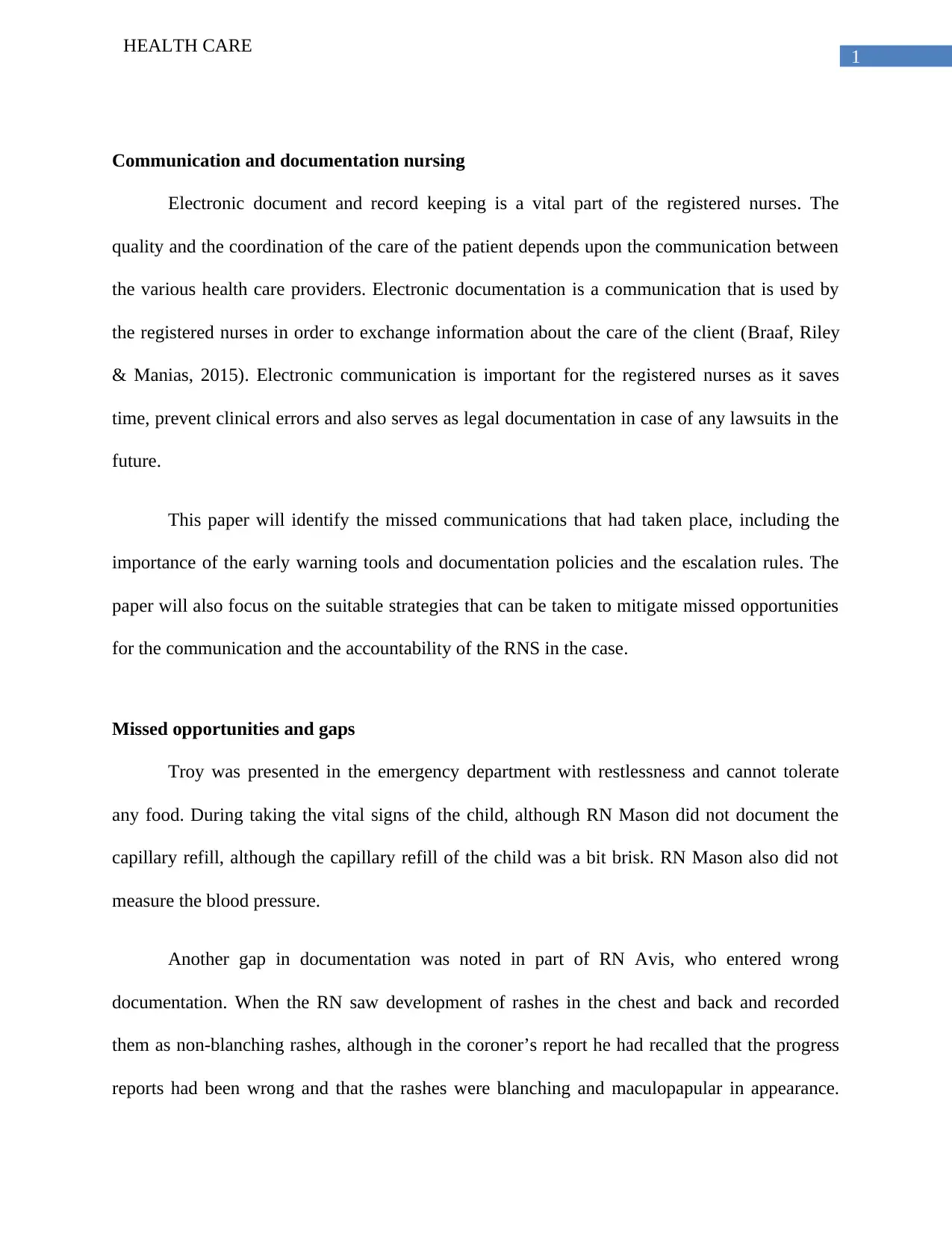
1
HEALTH CARE
Communication and documentation nursing
Electronic document and record keeping is a vital part of the registered nurses. The
quality and the coordination of the care of the patient depends upon the communication between
the various health care providers. Electronic documentation is a communication that is used by
the registered nurses in order to exchange information about the care of the client (Braaf, Riley
& Manias, 2015). Electronic communication is important for the registered nurses as it saves
time, prevent clinical errors and also serves as legal documentation in case of any lawsuits in the
future.
This paper will identify the missed communications that had taken place, including the
importance of the early warning tools and documentation policies and the escalation rules. The
paper will also focus on the suitable strategies that can be taken to mitigate missed opportunities
for the communication and the accountability of the RNS in the case.
Missed opportunities and gaps
Troy was presented in the emergency department with restlessness and cannot tolerate
any food. During taking the vital signs of the child, although RN Mason did not document the
capillary refill, although the capillary refill of the child was a bit brisk. RN Mason also did not
measure the blood pressure.
Another gap in documentation was noted in part of RN Avis, who entered wrong
documentation. When the RN saw development of rashes in the chest and back and recorded
them as non-blanching rashes, although in the coroner’s report he had recalled that the progress
reports had been wrong and that the rashes were blanching and maculopapular in appearance.
HEALTH CARE
Communication and documentation nursing
Electronic document and record keeping is a vital part of the registered nurses. The
quality and the coordination of the care of the patient depends upon the communication between
the various health care providers. Electronic documentation is a communication that is used by
the registered nurses in order to exchange information about the care of the client (Braaf, Riley
& Manias, 2015). Electronic communication is important for the registered nurses as it saves
time, prevent clinical errors and also serves as legal documentation in case of any lawsuits in the
future.
This paper will identify the missed communications that had taken place, including the
importance of the early warning tools and documentation policies and the escalation rules. The
paper will also focus on the suitable strategies that can be taken to mitigate missed opportunities
for the communication and the accountability of the RNS in the case.
Missed opportunities and gaps
Troy was presented in the emergency department with restlessness and cannot tolerate
any food. During taking the vital signs of the child, although RN Mason did not document the
capillary refill, although the capillary refill of the child was a bit brisk. RN Mason also did not
measure the blood pressure.
Another gap in documentation was noted in part of RN Avis, who entered wrong
documentation. When the RN saw development of rashes in the chest and back and recorded
them as non-blanching rashes, although in the coroner’s report he had recalled that the progress
reports had been wrong and that the rashes were blanching and maculopapular in appearance.
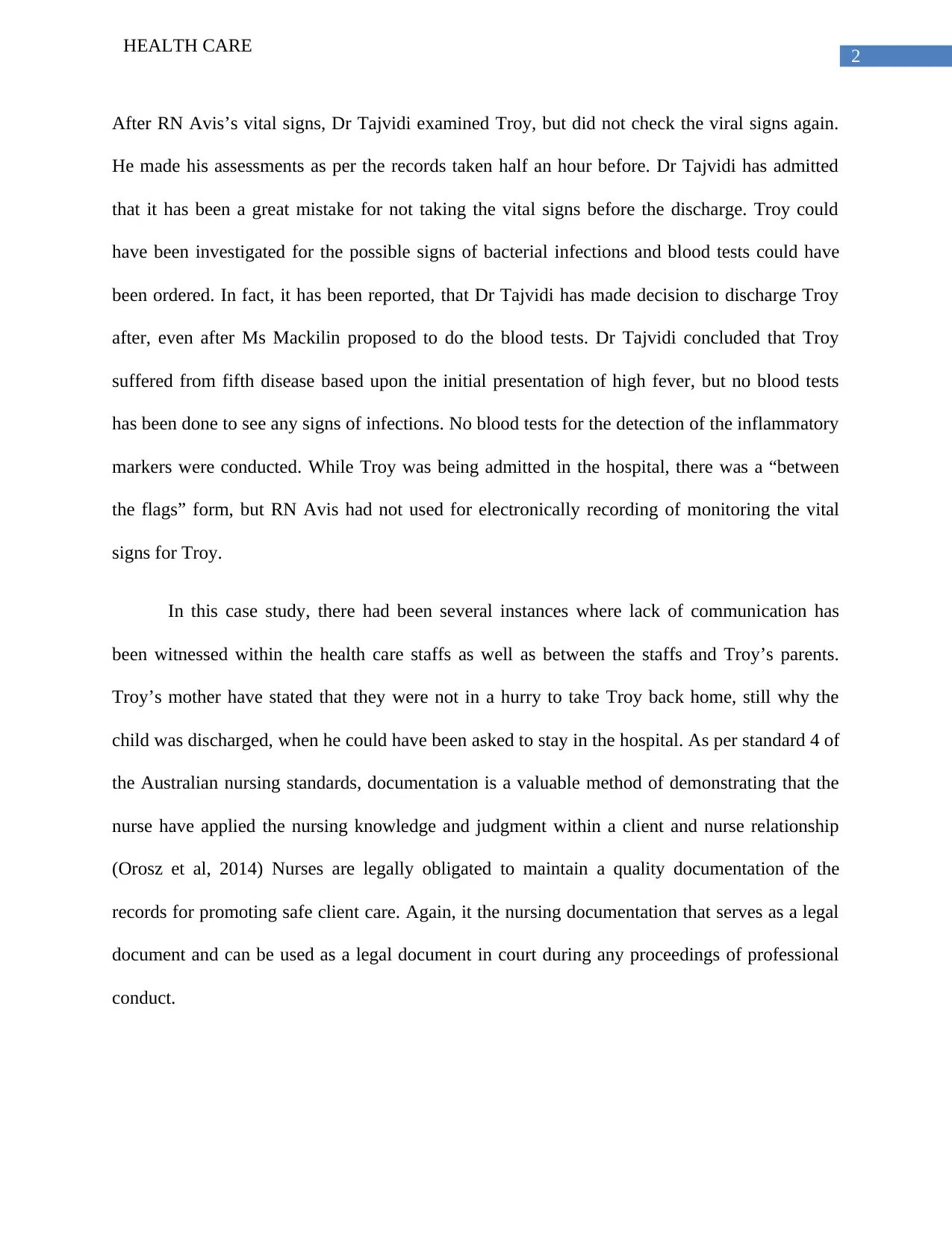
2
HEALTH CARE
After RN Avis’s vital signs, Dr Tajvidi examined Troy, but did not check the viral signs again.
He made his assessments as per the records taken half an hour before. Dr Tajvidi has admitted
that it has been a great mistake for not taking the vital signs before the discharge. Troy could
have been investigated for the possible signs of bacterial infections and blood tests could have
been ordered. In fact, it has been reported, that Dr Tajvidi has made decision to discharge Troy
after, even after Ms Mackilin proposed to do the blood tests. Dr Tajvidi concluded that Troy
suffered from fifth disease based upon the initial presentation of high fever, but no blood tests
has been done to see any signs of infections. No blood tests for the detection of the inflammatory
markers were conducted. While Troy was being admitted in the hospital, there was a “between
the flags” form, but RN Avis had not used for electronically recording of monitoring the vital
signs for Troy.
In this case study, there had been several instances where lack of communication has
been witnessed within the health care staffs as well as between the staffs and Troy’s parents.
Troy’s mother have stated that they were not in a hurry to take Troy back home, still why the
child was discharged, when he could have been asked to stay in the hospital. As per standard 4 of
the Australian nursing standards, documentation is a valuable method of demonstrating that the
nurse have applied the nursing knowledge and judgment within a client and nurse relationship
(Orosz et al, 2014) Nurses are legally obligated to maintain a quality documentation of the
records for promoting safe client care. Again, it the nursing documentation that serves as a legal
document and can be used as a legal document in court during any proceedings of professional
conduct.
HEALTH CARE
After RN Avis’s vital signs, Dr Tajvidi examined Troy, but did not check the viral signs again.
He made his assessments as per the records taken half an hour before. Dr Tajvidi has admitted
that it has been a great mistake for not taking the vital signs before the discharge. Troy could
have been investigated for the possible signs of bacterial infections and blood tests could have
been ordered. In fact, it has been reported, that Dr Tajvidi has made decision to discharge Troy
after, even after Ms Mackilin proposed to do the blood tests. Dr Tajvidi concluded that Troy
suffered from fifth disease based upon the initial presentation of high fever, but no blood tests
has been done to see any signs of infections. No blood tests for the detection of the inflammatory
markers were conducted. While Troy was being admitted in the hospital, there was a “between
the flags” form, but RN Avis had not used for electronically recording of monitoring the vital
signs for Troy.
In this case study, there had been several instances where lack of communication has
been witnessed within the health care staffs as well as between the staffs and Troy’s parents.
Troy’s mother have stated that they were not in a hurry to take Troy back home, still why the
child was discharged, when he could have been asked to stay in the hospital. As per standard 4 of
the Australian nursing standards, documentation is a valuable method of demonstrating that the
nurse have applied the nursing knowledge and judgment within a client and nurse relationship
(Orosz et al, 2014) Nurses are legally obligated to maintain a quality documentation of the
records for promoting safe client care. Again, it the nursing documentation that serves as a legal
document and can be used as a legal document in court during any proceedings of professional
conduct.
⊘ This is a preview!⊘
Do you want full access?
Subscribe today to unlock all pages.

Trusted by 1+ million students worldwide
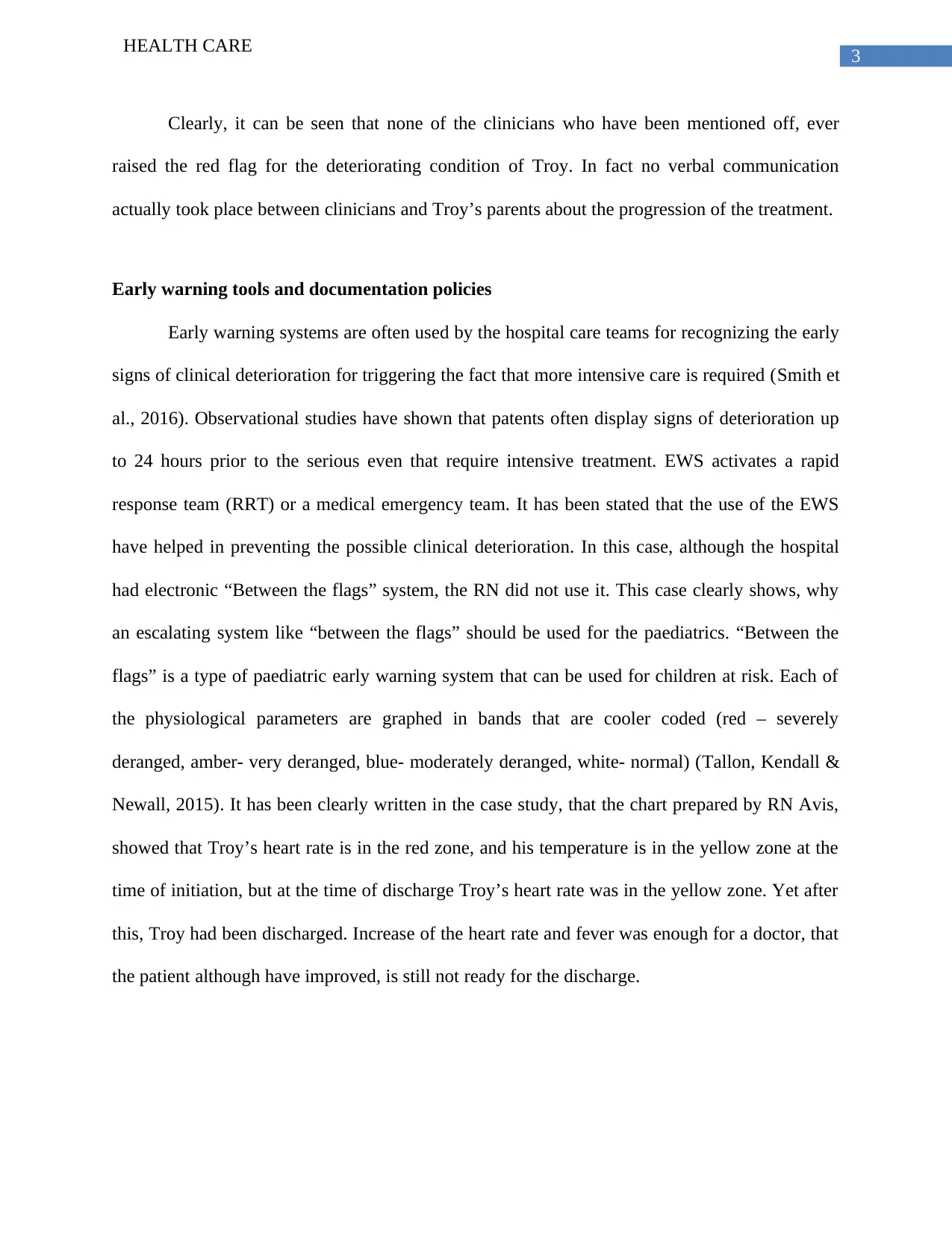
3
HEALTH CARE
Clearly, it can be seen that none of the clinicians who have been mentioned off, ever
raised the red flag for the deteriorating condition of Troy. In fact no verbal communication
actually took place between clinicians and Troy’s parents about the progression of the treatment.
Early warning tools and documentation policies
Early warning systems are often used by the hospital care teams for recognizing the early
signs of clinical deterioration for triggering the fact that more intensive care is required (Smith et
al., 2016). Observational studies have shown that patents often display signs of deterioration up
to 24 hours prior to the serious even that require intensive treatment. EWS activates a rapid
response team (RRT) or a medical emergency team. It has been stated that the use of the EWS
have helped in preventing the possible clinical deterioration. In this case, although the hospital
had electronic “Between the flags” system, the RN did not use it. This case clearly shows, why
an escalating system like “between the flags” should be used for the paediatrics. “Between the
flags” is a type of paediatric early warning system that can be used for children at risk. Each of
the physiological parameters are graphed in bands that are cooler coded (red – severely
deranged, amber- very deranged, blue- moderately deranged, white- normal) (Tallon, Kendall &
Newall, 2015). It has been clearly written in the case study, that the chart prepared by RN Avis,
showed that Troy’s heart rate is in the red zone, and his temperature is in the yellow zone at the
time of initiation, but at the time of discharge Troy’s heart rate was in the yellow zone. Yet after
this, Troy had been discharged. Increase of the heart rate and fever was enough for a doctor, that
the patient although have improved, is still not ready for the discharge.
HEALTH CARE
Clearly, it can be seen that none of the clinicians who have been mentioned off, ever
raised the red flag for the deteriorating condition of Troy. In fact no verbal communication
actually took place between clinicians and Troy’s parents about the progression of the treatment.
Early warning tools and documentation policies
Early warning systems are often used by the hospital care teams for recognizing the early
signs of clinical deterioration for triggering the fact that more intensive care is required (Smith et
al., 2016). Observational studies have shown that patents often display signs of deterioration up
to 24 hours prior to the serious even that require intensive treatment. EWS activates a rapid
response team (RRT) or a medical emergency team. It has been stated that the use of the EWS
have helped in preventing the possible clinical deterioration. In this case, although the hospital
had electronic “Between the flags” system, the RN did not use it. This case clearly shows, why
an escalating system like “between the flags” should be used for the paediatrics. “Between the
flags” is a type of paediatric early warning system that can be used for children at risk. Each of
the physiological parameters are graphed in bands that are cooler coded (red – severely
deranged, amber- very deranged, blue- moderately deranged, white- normal) (Tallon, Kendall &
Newall, 2015). It has been clearly written in the case study, that the chart prepared by RN Avis,
showed that Troy’s heart rate is in the red zone, and his temperature is in the yellow zone at the
time of initiation, but at the time of discharge Troy’s heart rate was in the yellow zone. Yet after
this, Troy had been discharged. Increase of the heart rate and fever was enough for a doctor, that
the patient although have improved, is still not ready for the discharge.
Paraphrase This Document
Need a fresh take? Get an instant paraphrase of this document with our AI Paraphraser
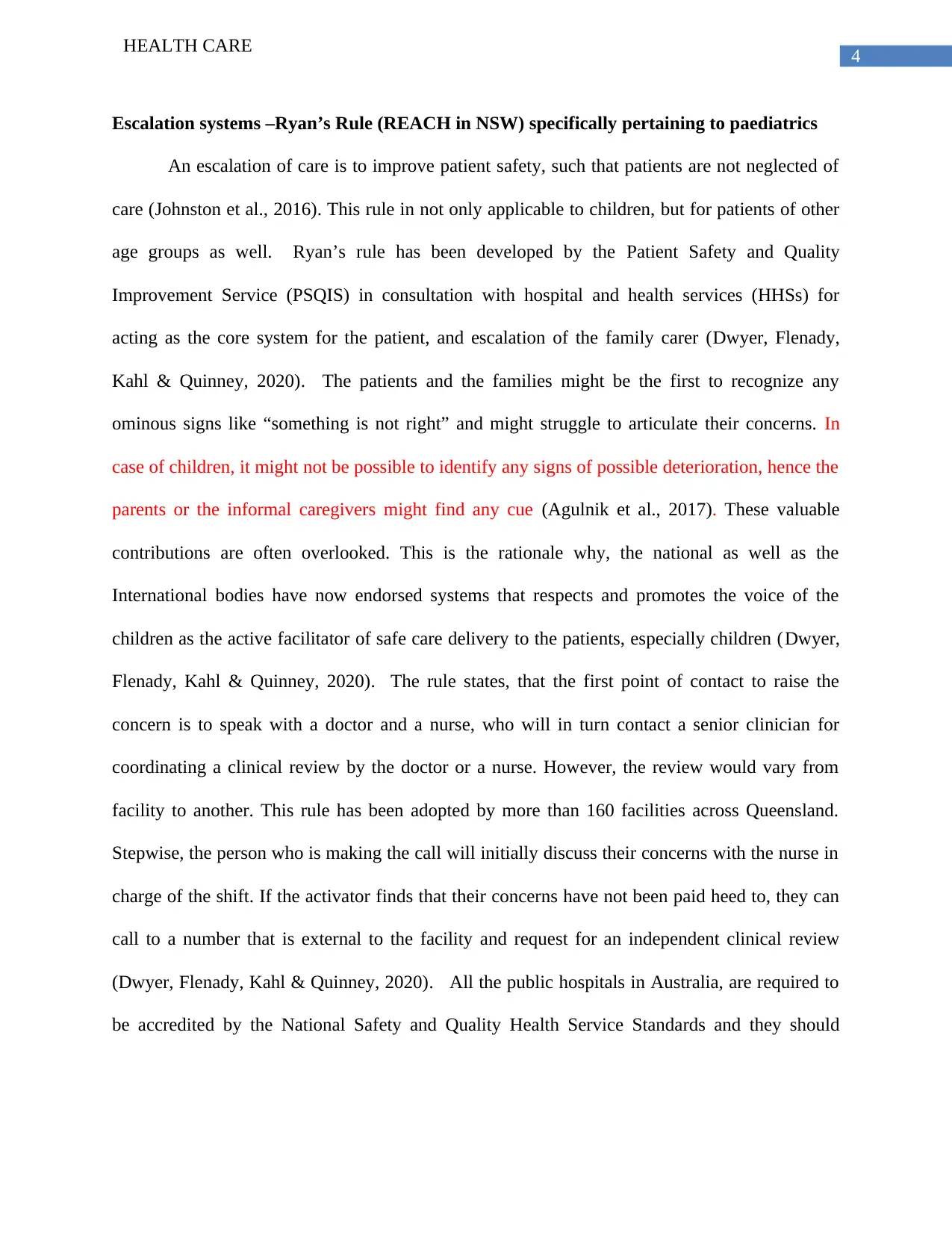
4
HEALTH CARE
Escalation systems –Ryan’s Rule (REACH in NSW) specifically pertaining to paediatrics
An escalation of care is to improve patient safety, such that patients are not neglected of
care (Johnston et al., 2016). This rule in not only applicable to children, but for patients of other
age groups as well. Ryan’s rule has been developed by the Patient Safety and Quality
Improvement Service (PSQIS) in consultation with hospital and health services (HHSs) for
acting as the core system for the patient, and escalation of the family carer (Dwyer, Flenady,
Kahl & Quinney, 2020). The patients and the families might be the first to recognize any
ominous signs like “something is not right” and might struggle to articulate their concerns. In
case of children, it might not be possible to identify any signs of possible deterioration, hence the
parents or the informal caregivers might find any cue (Agulnik et al., 2017). These valuable
contributions are often overlooked. This is the rationale why, the national as well as the
International bodies have now endorsed systems that respects and promotes the voice of the
children as the active facilitator of safe care delivery to the patients, especially children (Dwyer,
Flenady, Kahl & Quinney, 2020). The rule states, that the first point of contact to raise the
concern is to speak with a doctor and a nurse, who will in turn contact a senior clinician for
coordinating a clinical review by the doctor or a nurse. However, the review would vary from
facility to another. This rule has been adopted by more than 160 facilities across Queensland.
Stepwise, the person who is making the call will initially discuss their concerns with the nurse in
charge of the shift. If the activator finds that their concerns have not been paid heed to, they can
call to a number that is external to the facility and request for an independent clinical review
(Dwyer, Flenady, Kahl & Quinney, 2020). All the public hospitals in Australia, are required to
be accredited by the National Safety and Quality Health Service Standards and they should
HEALTH CARE
Escalation systems –Ryan’s Rule (REACH in NSW) specifically pertaining to paediatrics
An escalation of care is to improve patient safety, such that patients are not neglected of
care (Johnston et al., 2016). This rule in not only applicable to children, but for patients of other
age groups as well. Ryan’s rule has been developed by the Patient Safety and Quality
Improvement Service (PSQIS) in consultation with hospital and health services (HHSs) for
acting as the core system for the patient, and escalation of the family carer (Dwyer, Flenady,
Kahl & Quinney, 2020). The patients and the families might be the first to recognize any
ominous signs like “something is not right” and might struggle to articulate their concerns. In
case of children, it might not be possible to identify any signs of possible deterioration, hence the
parents or the informal caregivers might find any cue (Agulnik et al., 2017). These valuable
contributions are often overlooked. This is the rationale why, the national as well as the
International bodies have now endorsed systems that respects and promotes the voice of the
children as the active facilitator of safe care delivery to the patients, especially children (Dwyer,
Flenady, Kahl & Quinney, 2020). The rule states, that the first point of contact to raise the
concern is to speak with a doctor and a nurse, who will in turn contact a senior clinician for
coordinating a clinical review by the doctor or a nurse. However, the review would vary from
facility to another. This rule has been adopted by more than 160 facilities across Queensland.
Stepwise, the person who is making the call will initially discuss their concerns with the nurse in
charge of the shift. If the activator finds that their concerns have not been paid heed to, they can
call to a number that is external to the facility and request for an independent clinical review
(Dwyer, Flenady, Kahl & Quinney, 2020). All the public hospitals in Australia, are required to
be accredited by the National Safety and Quality Health Service Standards and they should
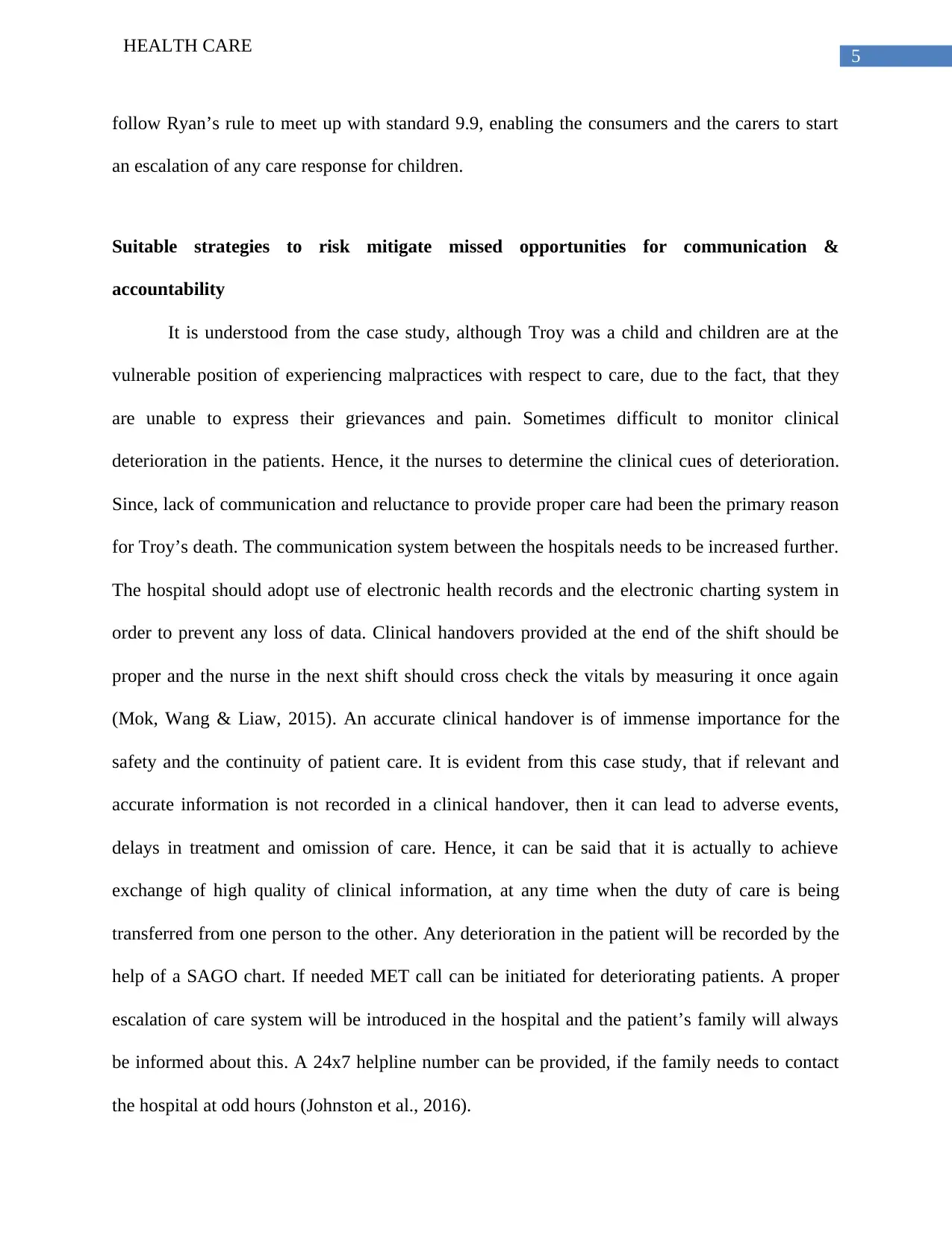
5
HEALTH CARE
follow Ryan’s rule to meet up with standard 9.9, enabling the consumers and the carers to start
an escalation of any care response for children.
Suitable strategies to risk mitigate missed opportunities for communication &
accountability
It is understood from the case study, although Troy was a child and children are at the
vulnerable position of experiencing malpractices with respect to care, due to the fact, that they
are unable to express their grievances and pain. Sometimes difficult to monitor clinical
deterioration in the patients. Hence, it the nurses to determine the clinical cues of deterioration.
Since, lack of communication and reluctance to provide proper care had been the primary reason
for Troy’s death. The communication system between the hospitals needs to be increased further.
The hospital should adopt use of electronic health records and the electronic charting system in
order to prevent any loss of data. Clinical handovers provided at the end of the shift should be
proper and the nurse in the next shift should cross check the vitals by measuring it once again
(Mok, Wang & Liaw, 2015). An accurate clinical handover is of immense importance for the
safety and the continuity of patient care. It is evident from this case study, that if relevant and
accurate information is not recorded in a clinical handover, then it can lead to adverse events,
delays in treatment and omission of care. Hence, it can be said that it is actually to achieve
exchange of high quality of clinical information, at any time when the duty of care is being
transferred from one person to the other. Any deterioration in the patient will be recorded by the
help of a SAGO chart. If needed MET call can be initiated for deteriorating patients. A proper
escalation of care system will be introduced in the hospital and the patient’s family will always
be informed about this. A 24x7 helpline number can be provided, if the family needs to contact
the hospital at odd hours (Johnston et al., 2016).
HEALTH CARE
follow Ryan’s rule to meet up with standard 9.9, enabling the consumers and the carers to start
an escalation of any care response for children.
Suitable strategies to risk mitigate missed opportunities for communication &
accountability
It is understood from the case study, although Troy was a child and children are at the
vulnerable position of experiencing malpractices with respect to care, due to the fact, that they
are unable to express their grievances and pain. Sometimes difficult to monitor clinical
deterioration in the patients. Hence, it the nurses to determine the clinical cues of deterioration.
Since, lack of communication and reluctance to provide proper care had been the primary reason
for Troy’s death. The communication system between the hospitals needs to be increased further.
The hospital should adopt use of electronic health records and the electronic charting system in
order to prevent any loss of data. Clinical handovers provided at the end of the shift should be
proper and the nurse in the next shift should cross check the vitals by measuring it once again
(Mok, Wang & Liaw, 2015). An accurate clinical handover is of immense importance for the
safety and the continuity of patient care. It is evident from this case study, that if relevant and
accurate information is not recorded in a clinical handover, then it can lead to adverse events,
delays in treatment and omission of care. Hence, it can be said that it is actually to achieve
exchange of high quality of clinical information, at any time when the duty of care is being
transferred from one person to the other. Any deterioration in the patient will be recorded by the
help of a SAGO chart. If needed MET call can be initiated for deteriorating patients. A proper
escalation of care system will be introduced in the hospital and the patient’s family will always
be informed about this. A 24x7 helpline number can be provided, if the family needs to contact
the hospital at odd hours (Johnston et al., 2016).
⊘ This is a preview!⊘
Do you want full access?
Subscribe today to unlock all pages.

Trusted by 1+ million students worldwide
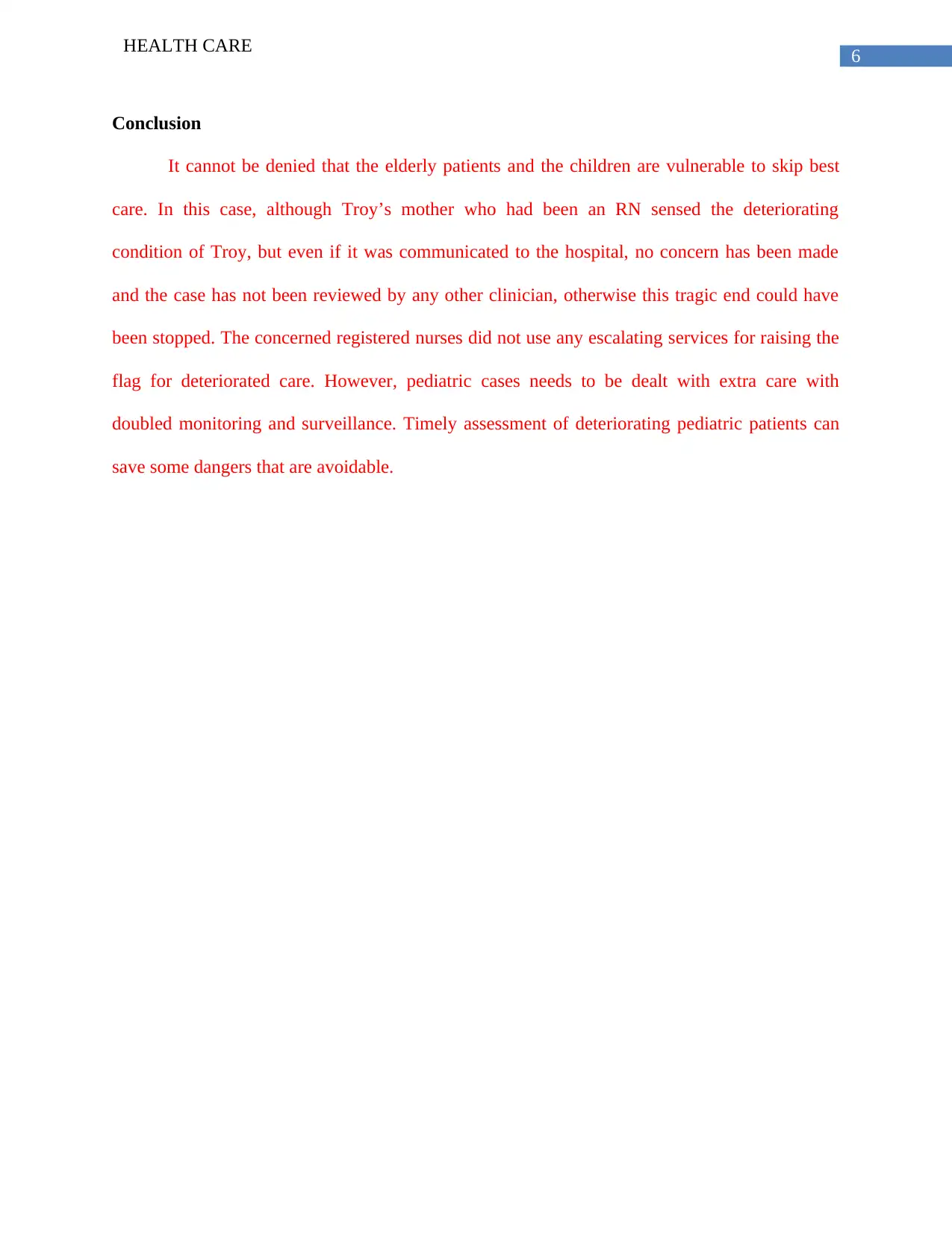
6
HEALTH CARE
Conclusion
It cannot be denied that the elderly patients and the children are vulnerable to skip best
care. In this case, although Troy’s mother who had been an RN sensed the deteriorating
condition of Troy, but even if it was communicated to the hospital, no concern has been made
and the case has not been reviewed by any other clinician, otherwise this tragic end could have
been stopped. The concerned registered nurses did not use any escalating services for raising the
flag for deteriorated care. However, pediatric cases needs to be dealt with extra care with
doubled monitoring and surveillance. Timely assessment of deteriorating pediatric patients can
save some dangers that are avoidable.
HEALTH CARE
Conclusion
It cannot be denied that the elderly patients and the children are vulnerable to skip best
care. In this case, although Troy’s mother who had been an RN sensed the deteriorating
condition of Troy, but even if it was communicated to the hospital, no concern has been made
and the case has not been reviewed by any other clinician, otherwise this tragic end could have
been stopped. The concerned registered nurses did not use any escalating services for raising the
flag for deteriorated care. However, pediatric cases needs to be dealt with extra care with
doubled monitoring and surveillance. Timely assessment of deteriorating pediatric patients can
save some dangers that are avoidable.
Paraphrase This Document
Need a fresh take? Get an instant paraphrase of this document with our AI Paraphraser
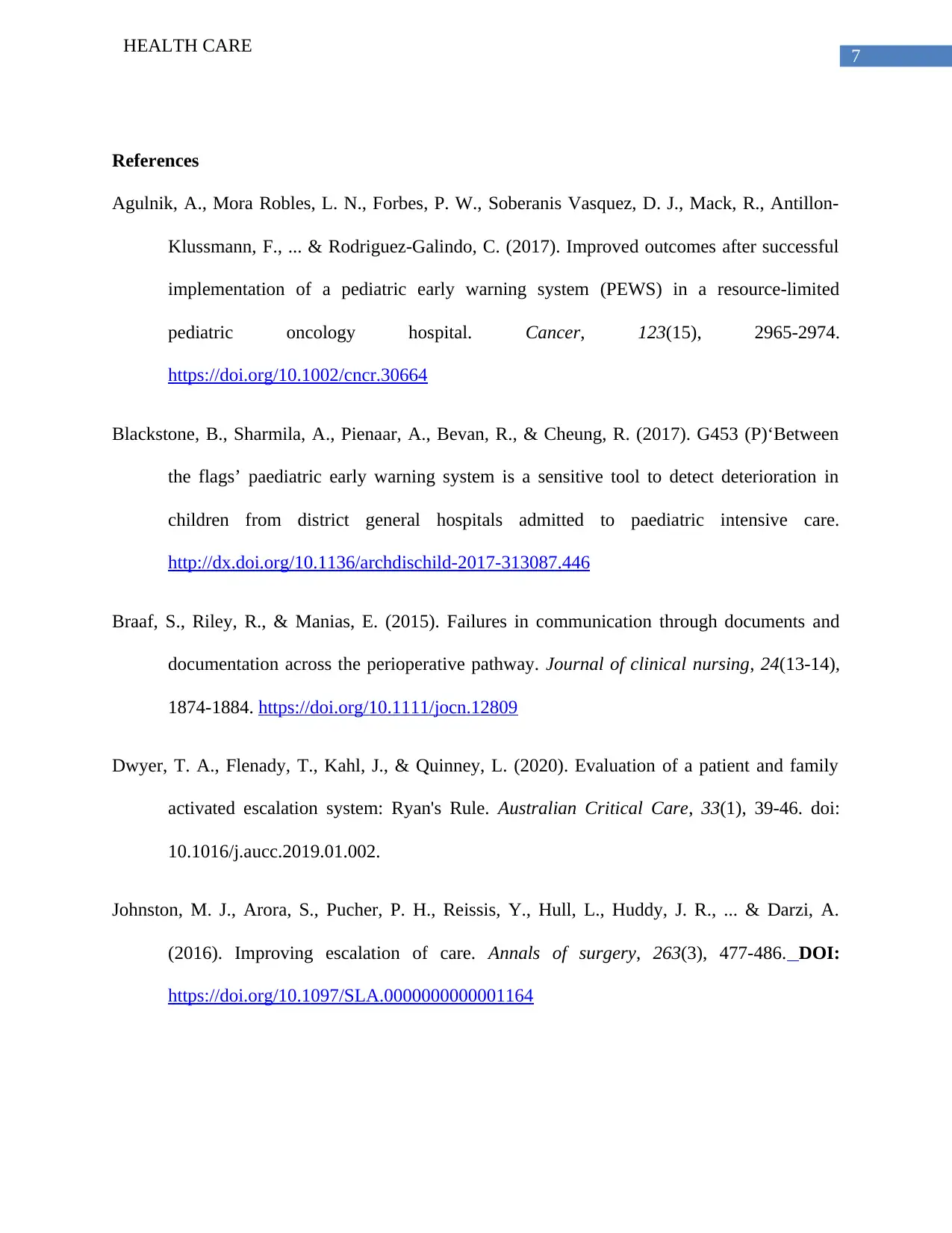
7
HEALTH CARE
References
Agulnik, A., Mora Robles, L. N., Forbes, P. W., Soberanis Vasquez, D. J., Mack, R., Antillon‐
Klussmann, F., ... & Rodriguez‐Galindo, C. (2017). Improved outcomes after successful
implementation of a pediatric early warning system (PEWS) in a resource‐limited
pediatric oncology hospital. Cancer, 123(15), 2965-2974.
https://doi.org/10.1002/cncr.30664
Blackstone, B., Sharmila, A., Pienaar, A., Bevan, R., & Cheung, R. (2017). G453 (P)‘Between
the flags’ paediatric early warning system is a sensitive tool to detect deterioration in
children from district general hospitals admitted to paediatric intensive care.
http://dx.doi.org/10.1136/archdischild-2017-313087.446
Braaf, S., Riley, R., & Manias, E. (2015). Failures in communication through documents and
documentation across the perioperative pathway. Journal of clinical nursing, 24(13-14),
1874-1884. https://doi.org/10.1111/jocn.12809
Dwyer, T. A., Flenady, T., Kahl, J., & Quinney, L. (2020). Evaluation of a patient and family
activated escalation system: Ryan's Rule. Australian Critical Care, 33(1), 39-46. doi:
10.1016/j.aucc.2019.01.002.
Johnston, M. J., Arora, S., Pucher, P. H., Reissis, Y., Hull, L., Huddy, J. R., ... & Darzi, A.
(2016). Improving escalation of care. Annals of surgery, 263(3), 477-486. DOI:
https://doi.org/10.1097/SLA.0000000000001164
HEALTH CARE
References
Agulnik, A., Mora Robles, L. N., Forbes, P. W., Soberanis Vasquez, D. J., Mack, R., Antillon‐
Klussmann, F., ... & Rodriguez‐Galindo, C. (2017). Improved outcomes after successful
implementation of a pediatric early warning system (PEWS) in a resource‐limited
pediatric oncology hospital. Cancer, 123(15), 2965-2974.
https://doi.org/10.1002/cncr.30664
Blackstone, B., Sharmila, A., Pienaar, A., Bevan, R., & Cheung, R. (2017). G453 (P)‘Between
the flags’ paediatric early warning system is a sensitive tool to detect deterioration in
children from district general hospitals admitted to paediatric intensive care.
http://dx.doi.org/10.1136/archdischild-2017-313087.446
Braaf, S., Riley, R., & Manias, E. (2015). Failures in communication through documents and
documentation across the perioperative pathway. Journal of clinical nursing, 24(13-14),
1874-1884. https://doi.org/10.1111/jocn.12809
Dwyer, T. A., Flenady, T., Kahl, J., & Quinney, L. (2020). Evaluation of a patient and family
activated escalation system: Ryan's Rule. Australian Critical Care, 33(1), 39-46. doi:
10.1016/j.aucc.2019.01.002.
Johnston, M. J., Arora, S., Pucher, P. H., Reissis, Y., Hull, L., Huddy, J. R., ... & Darzi, A.
(2016). Improving escalation of care. Annals of surgery, 263(3), 477-486. DOI:
https://doi.org/10.1097/SLA.0000000000001164
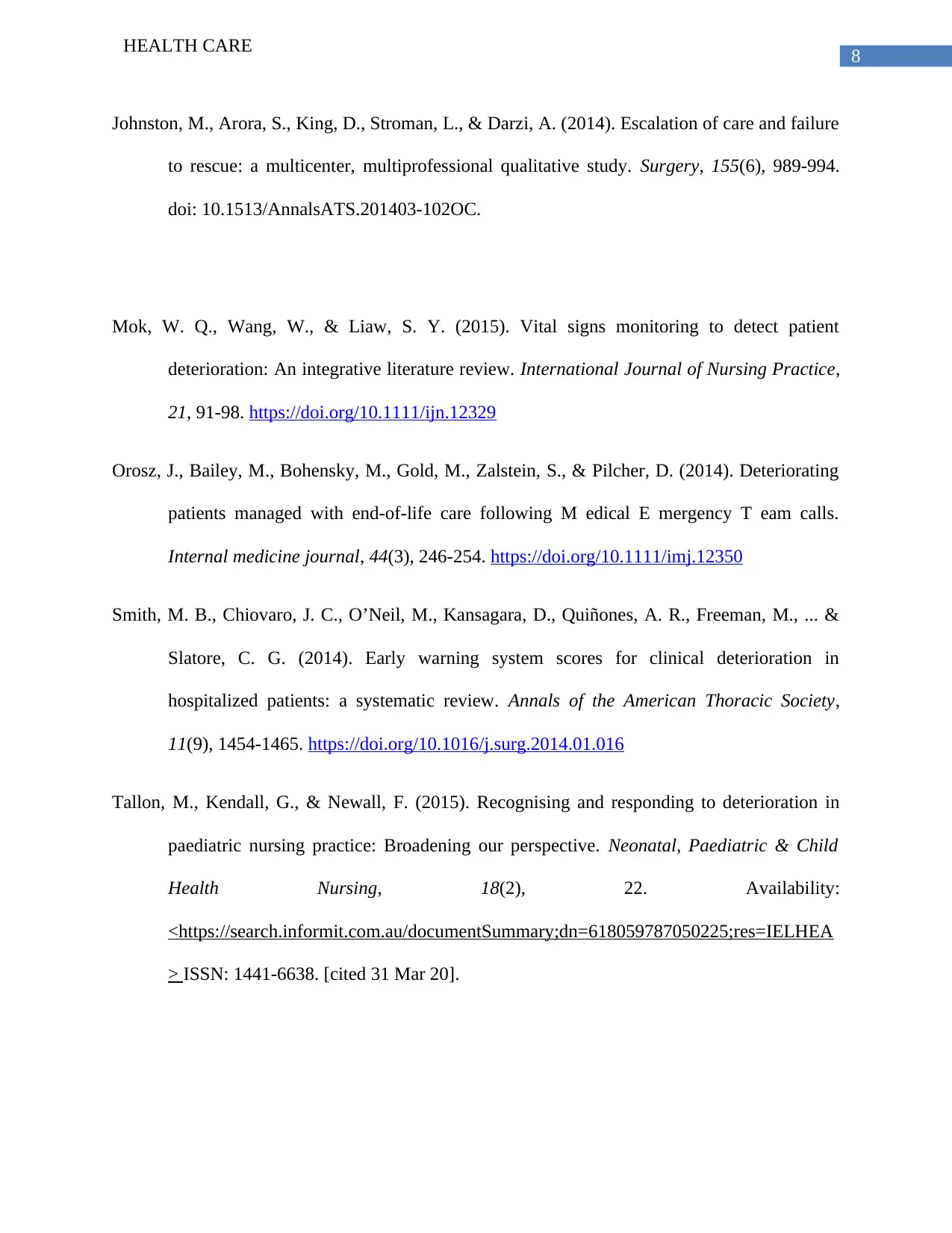
8
HEALTH CARE
Johnston, M., Arora, S., King, D., Stroman, L., & Darzi, A. (2014). Escalation of care and failure
to rescue: a multicenter, multiprofessional qualitative study. Surgery, 155(6), 989-994.
doi: 10.1513/AnnalsATS.201403-102OC.
Mok, W. Q., Wang, W., & Liaw, S. Y. (2015). Vital signs monitoring to detect patient
deterioration: An integrative literature review. International Journal of Nursing Practice,
21, 91-98. https://doi.org/10.1111/ijn.12329
Orosz, J., Bailey, M., Bohensky, M., Gold, M., Zalstein, S., & Pilcher, D. (2014). Deteriorating
patients managed with end‐of‐life care following M edical E mergency T eam calls.
Internal medicine journal, 44(3), 246-254. https://doi.org/10.1111/imj.12350
Smith, M. B., Chiovaro, J. C., O’Neil, M., Kansagara, D., Quiñones, A. R., Freeman, M., ... &
Slatore, C. G. (2014). Early warning system scores for clinical deterioration in
hospitalized patients: a systematic review. Annals of the American Thoracic Society,
11(9), 1454-1465. https://doi.org/10.1016/j.surg.2014.01.016
Tallon, M., Kendall, G., & Newall, F. (2015). Recognising and responding to deterioration in
paediatric nursing practice: Broadening our perspective. Neonatal, Paediatric & Child
Health Nursing, 18(2), 22. Availability:
<https://search.informit.com.au/documentSummary;dn=618059787050225;res=IELHEA
> ISSN: 1441-6638. [cited 31 Mar 20].
HEALTH CARE
Johnston, M., Arora, S., King, D., Stroman, L., & Darzi, A. (2014). Escalation of care and failure
to rescue: a multicenter, multiprofessional qualitative study. Surgery, 155(6), 989-994.
doi: 10.1513/AnnalsATS.201403-102OC.
Mok, W. Q., Wang, W., & Liaw, S. Y. (2015). Vital signs monitoring to detect patient
deterioration: An integrative literature review. International Journal of Nursing Practice,
21, 91-98. https://doi.org/10.1111/ijn.12329
Orosz, J., Bailey, M., Bohensky, M., Gold, M., Zalstein, S., & Pilcher, D. (2014). Deteriorating
patients managed with end‐of‐life care following M edical E mergency T eam calls.
Internal medicine journal, 44(3), 246-254. https://doi.org/10.1111/imj.12350
Smith, M. B., Chiovaro, J. C., O’Neil, M., Kansagara, D., Quiñones, A. R., Freeman, M., ... &
Slatore, C. G. (2014). Early warning system scores for clinical deterioration in
hospitalized patients: a systematic review. Annals of the American Thoracic Society,
11(9), 1454-1465. https://doi.org/10.1016/j.surg.2014.01.016
Tallon, M., Kendall, G., & Newall, F. (2015). Recognising and responding to deterioration in
paediatric nursing practice: Broadening our perspective. Neonatal, Paediatric & Child
Health Nursing, 18(2), 22. Availability:
<https://search.informit.com.au/documentSummary;dn=618059787050225;res=IELHEA
> ISSN: 1441-6638. [cited 31 Mar 20].
⊘ This is a preview!⊘
Do you want full access?
Subscribe today to unlock all pages.

Trusted by 1+ million students worldwide

9
HEALTH CARE
HEALTH CARE
1 out of 10
Related Documents
Your All-in-One AI-Powered Toolkit for Academic Success.
+13062052269
info@desklib.com
Available 24*7 on WhatsApp / Email
![[object Object]](/_next/static/media/star-bottom.7253800d.svg)
Unlock your academic potential
Copyright © 2020–2025 A2Z Services. All Rights Reserved. Developed and managed by ZUCOL.





